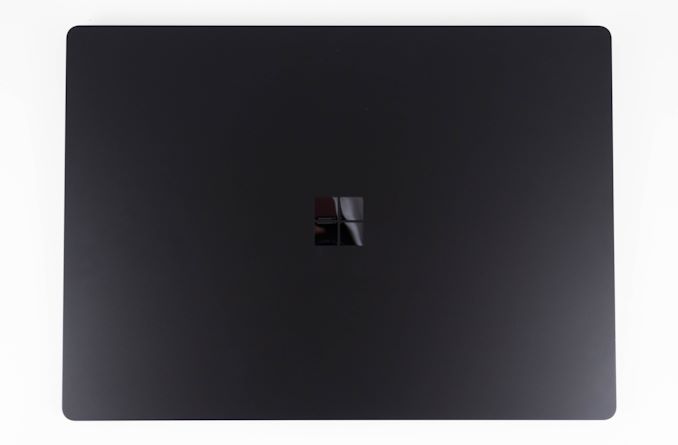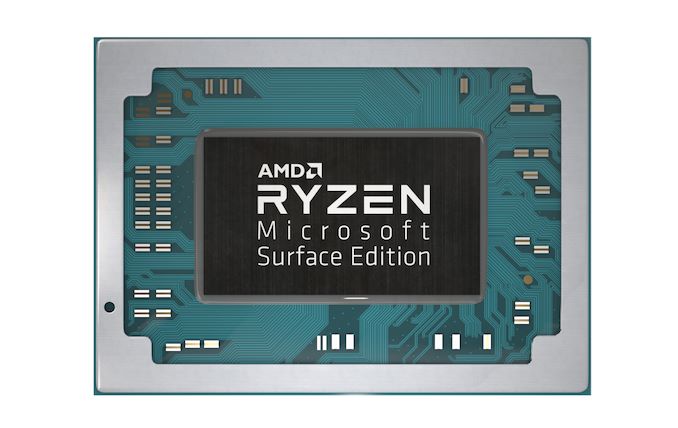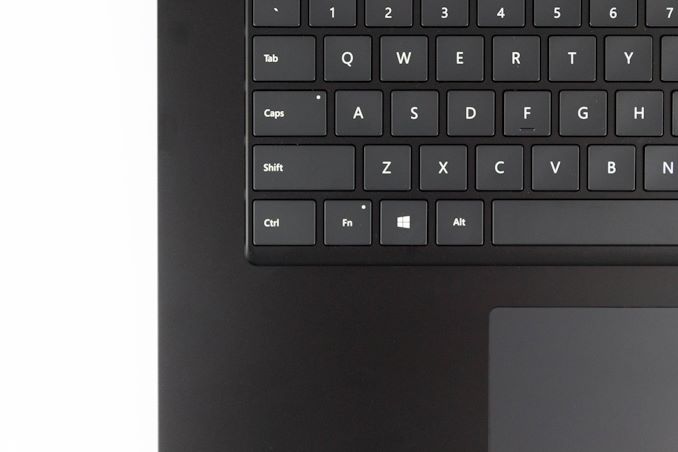The Microsoft Surface Laptop 3 (15-Inch) Review: AMD Ryzen Surface Edition
by Brett Howse on October 21, 2019 9:00 AM EST- Posted in
- Laptops
- AMD
- Microsoft
- Surface
- Ryzen
- Surface Laptop
- Surface Laptop 3
Final Words
The Surface Laptop was a fine device when it launched, and the Surface Laptop 2 improved it quite a bit with the addition of quad-core processors. But both had their success hampered somewhat by some bad design decisions, which Microsoft has thankfully corrected with the Surface Laptop 3 family.
Perhaps the most notable change here is the material itself. The Surface Laptop 2's Alcantara keyboard deck was an interesting choice: it offered an extremely comfortable typing surface, but some customers were concerned about its durability, and others were likely turned off by the look of it. For the Surface Laptop 3, Microsoft is providing more choice to their buyers by offering models with the fabric and without, at least on the 13.5-inch version. And for the 15-inch model, which is what we've reviewed today, it is only offered with an anodized aluminum finish.
The other major drawback with the original design was the lack of connectivity. Both the Surface Laptop and Surface Laptop 2 offered just a single USB port, which wasn't going to be sufficient for everyone. For the Surface Laptop 3, Microsoft has finally heeded requests to change this, and dropped the Mini DisplayPort connection for a USB-C port (with DP alt mode). This is a small change, but one that is going to be welcome practically every single time, and significantly widens Microsoft's audience.
The addition of a USB-C port not only adds expansion, it also offers a second, non-proprietary way to charge the laptop, which is going to be useful to many people. If there is one outstanding concern it's that we still miss out on Thunderbolt 3 support here, but while that would also be a welcome addition to a premium laptop offering for 2019, for most people it’s less of a concern than just getting a USB-C port to begin with.
Ultimately, by addressing those two original design decisions and adding a new, larger 15-inch offering, the Surface Laptop 3 lineup is in a much better place than its predecessors, and a much larger range of users are going to find it worth their consideration.
The Surface team continues to make some of the nicest devices around, and the Surface Laptop 3 upholds that tradition. The attention to detail on items like having every single device tested to ensure the initial opening of the laptop can be done with one finger is the kind of fanaticism not normally seen in the laptop space. The entire design is sleek, smooth, and light, and the color options are a welcome way to add even more choice for consumers.
By sticking with a 3:2 display, the proportions of the laptop are just better, and Microsoft has nailed the weight balance when held in any orientation. The added vertical of the display also lets you get more done with the device.
Now to discuss arguably the biggest decision Microsoft made with this generation of Surface Laptop: tapping AMD for their AMD Ryzen Microsoft Surface Edition processors. Only found on the consumer 15-inch models, this is a significant departure from prescient for Microsoft, and it comes at a bit of a strange time in terms of product cycles. Still, it's a partnership that Microsoft and AMD have said will take place over multiple years, so Microsoft is clearly planning for the long-term here.
There is no doubt that AMD’s APUs offer significantly more graphics performance than any of the previous generation of Intel U series chips could muster. Microsoft and AMD have even gone one step further with the Surface Edition APUs, adding even more GPU grunt by enabling another CU within the integrated Vega GPU. This cements the relationship. AMD gets to power a premium device, and Microsoft gets to keep a bit of the best to themselves.
What AMD has given Microsoft, in turn, is a potent processor. AMD has a stout GPU in Vega, which works surprisingly well at 15-Watts. But the Zen+ CPU core doesn’t offer the same CPU performance of even the previous gen Core-U series from Intel, leaving the Surface Laptop 3 trailing a bit in CPU tests. Meanwhile, platform power is a mixed bag; Microsoft and AMD have made some incredible strides here in bringing down AMD's platform power, but on the whole even the highly tuned 15-inch Surface Laptop 3 is hobbled a bit by a higher platform power draw that eats away at battery life. Even with Microsoft's help, there's only so much AMD can do with their current-generation silicon, especially without LPDDR4X support.
The wildcard for AMD here is that they have finally gotten a Ryzen Mobile APU into a highly visible, premium notebook right as Intel is launching their 10nm Ice Lake processors. Intel is promising better graphics on Ice Lake, along with better CPU performance, all while using less power. This is an issue to tackle in greater depth at another time, but the AMD-powered 15-inch Surface Laptop 3 will be competing with other 15-inch Ice Lake laptops, as well as the Intel-powered 13.5-inch model. So Ryzen and the Surface Laptop 3 will be facing some stiff competition.
Meanwhile, I have to make note of the WI-Fi situation. For all the Surface Laptop 3 gets right, it's coupled with a sub-par Wi-Fi 5 (802.11ac) solution. We've seen much better Wi-Fi 5 performance in other laptops, never mind the fact that laptops using Intel's latest wares are coming with Wi-Fi 6 support.
It is still good to see Microsoft pairing with AMD on a premium device. There is no doubt that there are customers who would prefer the AMD version, and any improvements the Surface team get added to Windows to further improve the AMD experience are going to benefit all AMD powered laptops. And, looking at the longer term picture, AMD has been providing plenty of headlines this year thanks to their Zen 2 core. So with this set to be a multi-year partnership, the future looks bright for AMD in the laptop space.
Moving back to the Surface Laptop 3, there are some other subtle changes to highlight. Microsoft has moved from soldered-down BGA SSDs to removable M.2 drives, albeit in a 2230 form factor. This does provide the option to replace the SSD if necessary, although accessing it isn't the easiest feat (and not one Microsoft recommends for end-users). The other upshot of this change is that it lets them move back to having four lanes of PCIe data, compared to just two lanes feeding the previous BGA SSDs.
The generous trackpad works well, and is improved by the taller aspect ratio of the display, allowing it to grow along both axis rather than being awkwardly wide. The new keyboard also works well, offering a bit of a quieter typing experience, and still offering great key feel, despite having slightly less throw than the Surface Book 2's keyboard.
Meanwhile, Microsoft continues to ship excellent displays in all of their devices. The 200 pixels-per-inch density of this Surface Laptop 3 matches the pixel density of the smaller 13.5-inch unit, all the while achieving excellent color accuracy out of box. It doesn’t have quite the display of the Surface Book 2, which is one of the best on any laptop, but it still holds its own.
Overall, the Surface Laptop 3 15 is a great laptop. It keeps all of the design cues of the smaller generation and just makes it a bit bigger, retaining the same thin & light design and keeping it easy to travel with. Microsoft has forged a solid partnership with AMD, and the Ryzen APU that's at the heart of this laptop brings with it great GPU performance and good CPU performance, even though it is at the cost of overall battery life. Plus, if you have been eyeing up the previous generation Surface Laptop 2 and were held up due to the USB situation – or uncertainty about the Alcantara keyboard deck – the new generation does offer fixes there, which makes the Surface Laptop 3 a much more palatable device.
As is typical with Surface devices, the pricing is as premium as the product though. The AMD-powered 15-inch Surface Laptop 3 comes in at $1199, just $200 less than a similarly configured Surface Book 2. AMD got into a premium device, but for customers to attain it, you will need to step up to the premium price level as well.














91 Comments
View All Comments
Icehawk - Thursday, October 24, 2019 - link
I get that we always want the best but I honestly don't know why it's harped on about how this device "only" does ~315 which is about as fast as a SSD can handle anyway - 1G connects for a single machine just don't matter in real life. More important to me is how reliable the connection is, which according to this review is solid.Eliadbu - Monday, October 21, 2019 - link
I'll give that the GPU is compelling but all other aspects of the APU are mediocre, especially the battery life which worse than average. I would like to see how the ice lake version compares to this APU.I think this machine proved why Intel still dominates the low power/thin and light laptops market.
Irata - Monday, October 21, 2019 - link
Did you look at the system performance benchmarks? Ryzen 5 does pretty well there (second place overall in PC Mark 10) and the list does not include any Core i5, only core i7.The only laptop that has a higher score is the top of the line Surface Book 2 with an i7 plus nVidia dGPU.
The Ryzen model tested here is the base model, btw.
Yes, battery life could certainly be better (although they do not test how well it does under load), but Surface Book Ryzen us not the worst - there are Intel based models that do less well.
phoenix_rizzen - Monday, October 21, 2019 - link
Yeah, if you consider this is the middle-of-the-road APU (R5) from AMD being benched against the top-of-the-line CPUs (i7) from Intel, it does really well. For most of the CPU benchmarks, it's right in the middle of the i7 pack. For most of the GPU benchmarks, it's better than the iGPU, as good as the MX150 dGPU, although not nearly as good (as expected) as the 1060 dGPU.Would be interesting to see how this APU compares to i5 versions of these laptops.
Would also be interesting to see how the R7 APUs compare to the i5 and i7 versions of these laptops.
Eliadbu - Monday, October 21, 2019 - link
this is 8th gen, meaning we are comparing to the past products, you talked about r7 but from what I've seen we are talking 100-200mhz difference (so 5% difference at most ). also the TDP will get up as clock speed goes up which equal to more heat,worse battery life etc. many test that it did perform good is due the GPU as I said it is compelling but is it enough I would say no, and for testing battery life under load I would say while it might have some use cases most people will use the laptop on battery for basic tests like browsing the web, watch videos, edit documents or other light use programs. if the r5/r7 had lower price I would give it more favor but as it stands out it does not give us any discount, it may have been due Microsoft pricing tactics but it does not change the fact. also we need to see how it compares to ICL version of this machine. I would guess it would still have the better GPU but the gap would shrink significantly, and CPU would not be it strong side either.Potato Power - Thursday, October 24, 2019 - link
Microsoft puts a 46Wh battery inside. That explains why the battery life is only so so. Even my cheapy Zenbook has a bigger battery.sorten - Monday, October 21, 2019 - link
Decent showing against previous generation Intel options, meaning it wasn't as far behind as I expected. Unfortunately for AMD, Ice Lake offers better than 2x the iGPU performance of 8th gen chips, and there will also be a minor bump on CPU performance, battery performance, and memory speed.Kishoreshack - Monday, October 21, 2019 - link
People overreacting should understand this is the base model, for a base model it competes very we with top end models of last yearI would be really excited to see higher end models of surface laptop 3
AMD VS INTEL COMPARISON
Felt that surface should have integrated ZEN 2 ARCHITECTURE INTO THESE LAPTOPS
TheinsanegamerN - Monday, October 21, 2019 - link
Except this "base" model has worse IRL GPU performance, worse batery life, and worse wifi. It is a step backwards. AMD GPUs are supposed to be better then intel, but the graphs here show that is not hte case unless power isnt a consideration.Kind of hard for MS to use ZEN 2 ARCHITECTURE APUs when they refuse to make them. AMD is just crippling themselves here.
Fulljack - Tuesday, October 22, 2019 - link
eh, it shows the igpu as the most powerful one, even beating mx150 which is a dgpu on some scenario. too bad the graph still hasn't show Intel gen11 graphics. so I don't get what do you mean by worse irl gpu performance.of course, as expected, it won't beat gtx 1060 due to sheer amount of difference both in tdp and die size.